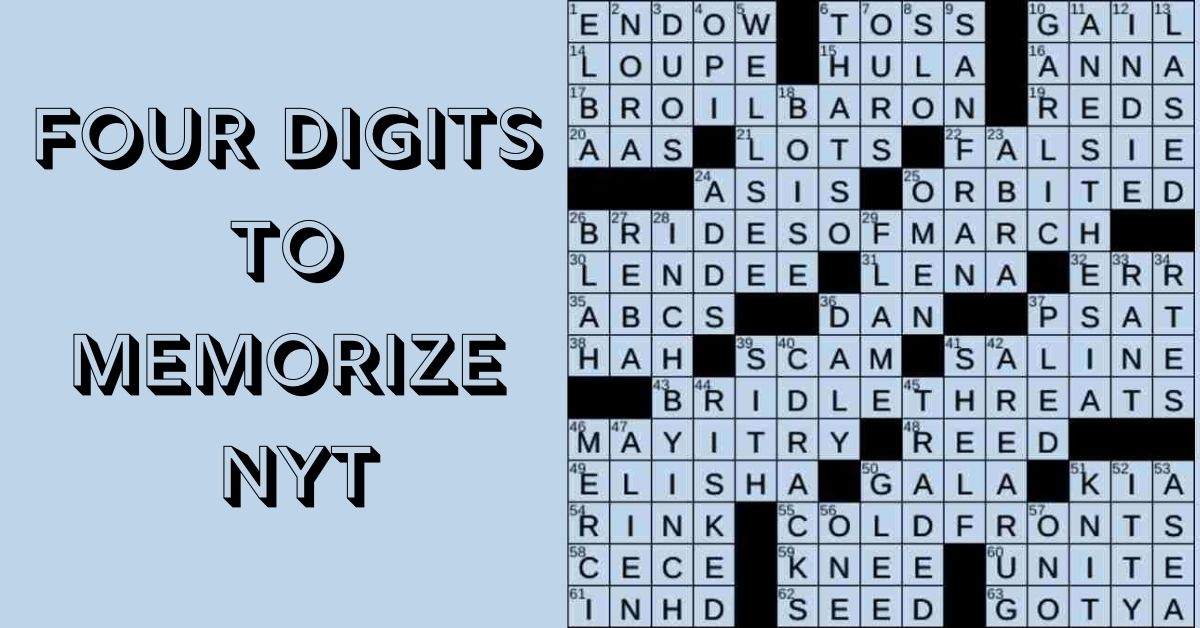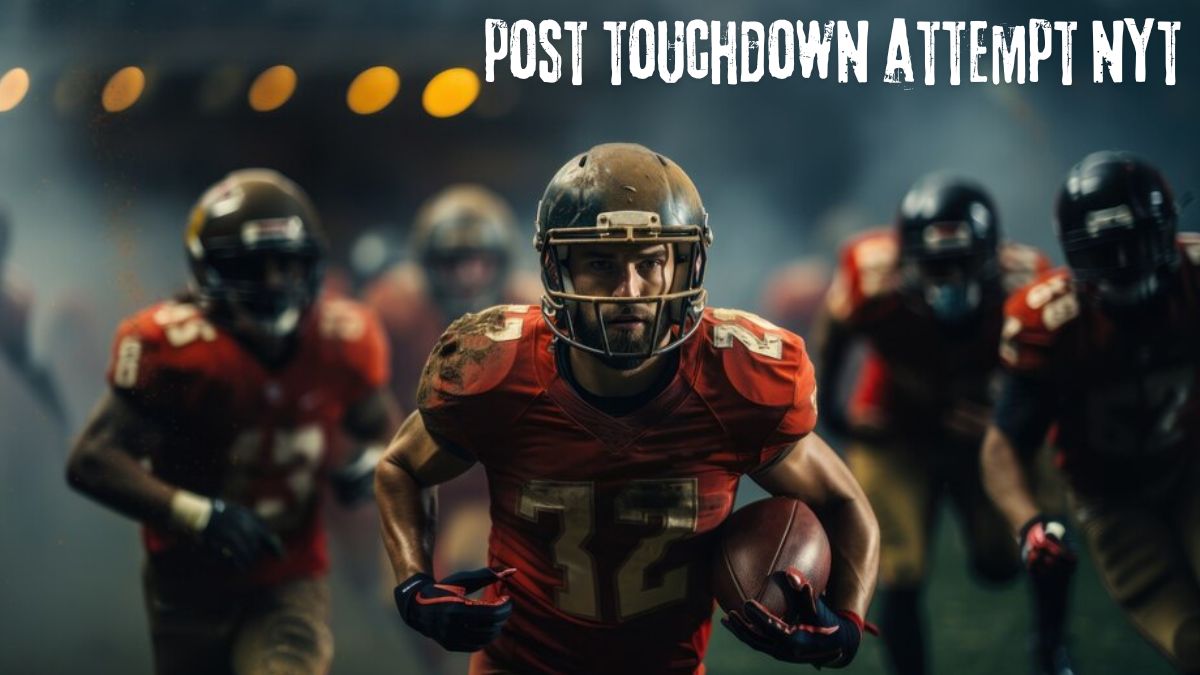GAMES
Unlocking the Potential of “Four Digits to Memorize”

In today’s fast-paced world, where information overload is a common challenge, the ability to remember important details is more crucial than ever. Memorization techniques have long been employed to enhance memory retention, and one such method that has gained traction is the use of “four digits to memorize nyt.” In this article, we delve into the intricacies of this technique, exploring its applications, benefits, and practical tips for implementation.
Understanding Memory Techniques
Before diving into the specifics of four-digit codes, it’s essential to grasp the fundamentals of memory techniques. Mnemonic devices, such as acronyms, visualization, and association, are tools used to aid memory recall. These techniques capitalize on the brain’s innate ability to remember vivid and meaningful information more effectively than arbitrary data.
The Power of Four-Digit Codes
Four-digit codes are sequences of numbers consisting of four digits to memorize nyt each, typically ranging from 0000 to 9999. Despite their simplicity, these codes hold significant potential in various contexts. From unlocking safes to setting passwords, four-digit codes are ubiquitous in modern society.
How to Create Memorable Four-Digit Codes
Crafting memorable four-digit codes involves a strategic approach. By associating each number with vivid imagery or personal meaning, individuals can enhance their recall ability. For instance, assigning words or phrases to numerical sequences can transform mundane combinations into memorable codes.
Applications in Everyday Life
The versatility of four digits to memorize nyt codes extends beyond conventional uses. In personal life, individuals can utilize these codes to remember important dates, phone numbers, or addresses. Moreover, in professional settings, four-digit codes can streamline processes and improve efficiency.
Memory Competitions and Techniques
Memory competitions serve as a testament to the remarkable capabilities of human memory. Competitors employ various techniques, including the memorization of long sequences of digits, to demonstrate their mnemonic prowess. Through rigorous training and dedication, participants hone their memory skills to extraordinary levels.
Improving Cognitive Functions
Engaging in memory training not only enhances memory retention but also contributes to overall cognitive function. Studies have shown that regular practice of memorization techniques can lead to improved concentration, problem-solving skills, and mental agility.
Challenges and Solutions
While memorization techniques offer numerous benefits, they are not without challenges. Distractions, information overload, and forgetfulness are common hurdles faced by individuals seeking to improve their memory. However, by implementing effective strategies such as repetition and spaced retrieval, these obstacles can be overcome.
Digital Security and Four-Digit Codes
In an era dominated by digital technology, the importance of secure passwords cannot be overstated. Four-digit codes play a crucial role in digital security, serving as PINs for bank accounts, access codes for electronic devices, and authentication codes for online platforms.
Ethical Considerations
As with any tool, mnemonic devices raise ethical considerations regarding privacy and data security. Users must exercise caution when employing memorization techniques to safeguard sensitive information and respect the privacy of others.
Future Trends and Innovations
The field of memory enhancement continues to evolve, driven by advancements in technology and neuroscience. From brain-computer interfaces to neurostimulation devices, researchers are exploring novel approaches to boost memory capabilities and unlock the full potential of the human mind.
Conclusion
“four digits to memorize nyt” offers a simple yet powerful method for enhancing memory retention and cognitive function. By leveraging mnemonic techniques and embracing the versatility of four-digit codes, individuals can unlock new realms of memory mastery and achieve greater success in both personal and professional endeavors.
FAQs
How can I improve my memory using four-digit codes?
Practice associating each digit with memorable images or words to create vivid mental representations.
Are there any limitations to using four-digit codes?
While effective for many purposes, four-digit codes may not be suitable for securing highly sensitive information.
Can children benefit from learning mnemonic techniques?
Yes, mnemonic devices can be valuable tools for children to improve their memory and academic performance.
What is the best way to incorporate four-digit codes into my daily routine?
Start by identifying areas where you frequently use numerical sequences, such as passwords or phone numbers, and begin substituting them with memorable four-digit codes.
Is there any scientific evidence supporting the effectiveness of memory techniques?
Yes, numerous studies have demonstrated the efficacy of mnemonic devices in enhancing memory retention and cognitive function.

GAMES
Codes eSports: The Future of Competitive Gaming

Codes etruesports has become a global phenomenon, captivating millions of viewers worldwide. Whether it’s League of Legends, Dota 2, or Fortnite, competitive gaming has found its place in the hearts of fans and players alike. A key player in the world of eSports is Codes eSports, a team that has gained significant recognition and is setting a high bar for performance in competitive gaming. In this article, we’ll explore what Codes eSports is all about, its journey to success, and the role it plays in the rapidly growing eSports industry.
What is Codes eSports?
Codes eSports is a professional eSports organization that participates in various competitive video games. Founded with the goal of bringing top-tier players together, the team quickly rose to prominence due to its dedication to excellence and competitive spirit. They compete in some of the most popular titles in the gaming industry, including first-person shooters, multiplayer online battle arenas (MOBAs), and real-time strategy games.
The Origins of Codes eSports
Every success story has its beginnings, and Codes eSports is no exception. Starting as a small organization, it aimed to bring together a group of passionate gamers. With the rise of online multiplayer games, Codes eSports took advantage of the growing trend, forming a team that could compete with the best of the best.
The Evolution of Codes eSports
Over the years, Codes eSports evolved from a modest team into a force to be reckoned with. As the team gained recognition in the competitive gaming scene, they secured sponsorships, entered larger tournaments, and attracted some of the best talent in the industry.
The Games Codes eSports Competes In
Codes eSports participates in several key competitive titles that have massive followings across the globe. Some of the top games include:
1. League of Legends (LoL)
League of Legends is one of the most popular MOBAs globally, and Codes eSports has a dedicated roster competing at the highest level. LoL is known for its strategic depth and fast-paced gameplay, making it a favorite among fans and players alike.
2. Counter-Strike: Global Offensive (CS:GO)
As one of the most iconic first-person shooters in the world, CS:GO has a deep and rich competitive scene. Codes eSports competes in numerous CS:GO tournaments, showcasing their tactical gameplay and precision shooting.
3. Valorant
Valorant is a newer addition to the competitive eSports scene, but its rapid rise has made it a favorite among gamers. The tactical shooter blends elements from both CS:GO and Overwatch, and Codes eSports has a dedicated Valorant team that competes at the highest level.
4. Fortnite
Fortnite revolutionized the battle royale genre, and Codes eSports has seen success in this competitive landscape as well. Players from all over the world compete in Fortnite tournaments, and Codes eSports has produced standout performances in major events.
The Importance of Teamwork in Codes eSports
A key factor that sets Codes eSports apart from many other teams is its focus on teamwork. eSports isn’t just about individual skill; it’s about synergy, coordination, and communication between teammates. Codes eSports has a team-first mentality, which is a significant reason behind their success.
The Role of Coaches and Analysts
Behind every successful eSports team, there’s a group of dedicated coaches and analysts who study opponents, strategize for upcoming matches, and ensure that players are constantly improving. Codes eSports is no different, and their coaching staff plays a critical role in shaping the team’s performance.
The Mental and Physical Demands of eSports
eSports requires both mental acuity and physical stamina. Players must be able to focus for hours on end, make split-second decisions, and deal with the pressure of competing at the highest level. Codes eSports emphasizes the well-being of its players, ensuring they have the tools and support necessary to stay sharp.
Codes eSports’ Impact on the Industry
eSports’ influence extends beyond the games they play. As one of the more prominent teams in the competitive gaming world, they have helped push eSports into the mainstream. Their success has played a part in increasing visibility for eSports, attracting sponsorships, and even bringing attention from traditional sports organizations.
The Rise of Sponsorships
Sponsorships are a huge part of the eSports ecosystem, and Codes eSports has successfully partnered with several high-profile brands. These partnerships provide the team with the resources needed to continue competing at the highest level while also promoting products and services to a dedicated fanbase.
eSports in the Mainstream Media
In recent years, eSports has been featured more frequently in mainstream media, and Codes eSports has contributed to this shift. The team’s success stories are often highlighted in gaming publications, TV shows, and even social media platforms. As a result, eSports is no longer a niche pastime but a growing industry.
How Codes eSports Engages with Fans
Engagement with fans is a critical aspect of any successful eSports organization. Codes eSports maintains an active presence on social media platforms like Twitter, Instagram, and YouTube, providing fans with regular updates, behind-the-scenes content, and highlights from major tournaments.
Streaming and Live Broadcasts
To connect with their fans even more, Codes eSports streams its matches and training sessions on platforms like Twitch. This allows fans to watch the team in action and cheer them on during crucial moments. Fans also get to interact with players and team members in real-time, creating a unique and personal connection.
The Future of Codes eSports
The future looks incredibly bright for Codes eSports. With the gaming landscape continually evolving, the team is well-positioned to capitalize on new opportunities. Whether it’s expanding into new games, entering new regions, or attracting even bigger sponsors, Codes eSports is poised for continued growth.
Potential Game Expansions
As the world of competitive gaming grows, new titles emerge. Codes eSports is always on the lookout for new opportunities, considering expanding their roster to compete in emerging games that are gaining traction in the eSports community.
Global Expansion and New Talent
Another exciting possibility for the future of Codes eSports is its expansion into international markets. The organization is already well-known in certain regions, but expanding globally will open up new competitive opportunities and help them recruit top-tier talent from around the world.
Conclusion: Codes eSports’ Legacy in Competitive Gaming
Codes eSports has become a trailblazer in the world of competitive gaming. Through their commitment to excellence, teamwork, and fan engagement, they have made a lasting impact on the eSports industry. As the team continues to rise in prominence, it’s clear that Codes eSports will play a central role in shaping the future of gaming at the highest level.
FAQs
What games does Codes eSports compete in?
Codes etruesports competes in popular games like League of Legends, CS:GO, Valorant, and Fortnite.
How important is teamwork in eSports?
Teamwork is crucial in eSports, as coordination, communication, and synergy between teammates are essential for success.
How does codes etruesports engage with its fans?
Codes eSports engages with fans through social media, live streams on Twitch, and behind-the-scenes content.
What does the future hold for Codes etruesports?
The future looks bright with potential game expansions, global growth, and the recruitment of new talent.
How does Codes eSports contribute to the growth of eSports?
By consistently performing at a high level, codes etruesports has helped raise awareness and visibility for the eSports industry.
READ MORE: CLICK HERE
GAMES
Exploring SilkTest.org Tech Talks: Comprehensive Guide

In the fast-paced world of software development, staying updated with the latest tools, technologies, and best practices is crucial. One platform that has been at the forefront of this knowledge-sharing movement is SilkTest.org. SilkTest, known for its robust automation testing capabilities, hosts tech talks that bring together professionals from across the globe to discuss industry trends, showcase new technologies, and share insights. In this article, we’ll delve into what SilkTest is, why its tech talks are so valuable, and how you can benefit from attending them.
What is SilkTest?
SilkTest is a comprehensive software testing tool developed to automate the process of testing applications. It is particularly known for its strength in functional and regression testing, making it a preferred choice for many organizations that need to test complex, large-scale applications.
Brief History of SilkTest
SilkTest has been around for decades, evolving along with the software testing landscape. Initially launched as a product by Segue Software in the 1990s, it was later acquired by Micro Focus, which has continued to develop and support it. The tool has kept pace with the rapid changes in the tech industry, ensuring it remains relevant in today’s fast-moving market.
MUST READ: The How of Digital and Analytics in Insurance
Purpose and Functionalities of SilkTest
The main purpose of SilkTest is to facilitate automated testing for software applications. It helps teams reduce manual testing efforts, enhance accuracy, and speed up the testing process. SilkTest provides the following core functionalities:
- Automated Testing: SilkTest automates the execution of test cases, reducing human error and ensuring faster results.
- Cross-Platform Testing: SilkTest supports testing across various platforms, including web, desktop, and mobile applications.
- Integration with Other Tools: SilkTest integrates seamlessly with CI/CD tools, version control systems, and bug tracking tools to streamline the entire testing process.
Key Features of SilkTest
Automated Testing Capabilities
Automation is one of the key strengths of SilkTest. By automating repetitive and time-consuming tasks, SilkTest allows developers to focus on writing better code rather than manually executing test cases. This significantly shortens the development cycle and enhances the reliability of the software.
Cross-Platform Testing Support
In today’s software environment, applications need to be tested across multiple platforms and devices. SilkTest supports a wide range of platforms, including web browsers (Chrome, Firefox, Internet Explorer), desktop applications (Windows), and mobile devices (iOS, Android). This versatility ensures that developers and testers can conduct thorough tests across all environments where their applications will run.
Integration with Other Tools
SilkTest integrates with a wide array of testing and development tools, including Jenkins for continuous integration, Jira for issue tracking, and Git for version control. This makes it an excellent choice for teams working in modern, agile environments where collaboration and integration are key to success.
The Importance of Automation in Software Testing
Automation has become a necessity in the modern software development lifecycle. With the demand for faster releases and continuous delivery, manual testing simply can’t keep up. Automated testing tools like SilkTest ensure that tests are consistent, repeatable, and efficient.
The Need for Automation in Modern Development Cycles
As software complexity grows, the need for thorough testing becomes more critical. However, the sheer volume of tests required to validate every feature and fix bugs makes manual testing inefficient. Automation solves this by running tests repeatedly and quickly, ensuring a higher level of accuracy with less effort. This allows developers to catch bugs earlier in the development process and deliver high-quality software faster.
How SilkTest Contributes to Efficiency in Testing
SilkTest contributes to the efficiency of the testing process by reducing the time spent on manual test execution. It can automatically run thousands of test cases across multiple platforms and generate detailed reports, enabling teams to identify and resolve issues before they impact production.
Tech Talks: A Platform for Knowledge Sharing
SilkTest.org tech talks serve as a powerful platform for professionals to learn, share, and connect. These events cover a wide range of topics relevant to testers, developers, and QA professionals. The aim of these tech talks is to foster a sense of community, keep industry professionals updated on the latest trends, and provide valuable insights that can improve their day-to-day work.
The Role of Tech Talks in the Software Industry
Tech talks have become an essential part of the software development ecosystem. They allow experts to share their knowledge, showcase new tools, and discuss the latest methodologies. These events are often interactive, with live demonstrations, Q&A sessions, and networking opportunities that allow attendees to gain hands-on experience and learn directly from industry leaders.
SilkTest hosts tech talks to engage with the software testing community and promote best practices. By bringing experts together to share their experiences, SilkTest ensures that its users are always up-to-date with the latest advancements in testing automation, methodologies, and tools.
Benefits of Attending SilkTest Tech Talks
Attending a SilkTest tech talk can be a game-changer for professionals in the software development and testing world. Here’s why:
Networking Opportunities
Tech talks are a great place to meet other professionals in the industry. Networking with peers, experts, and influencers can open doors to new career opportunities, collaborations, and partnerships.
Learning from Industry Experts
One of the biggest draws of SilkTest tech talks is the chance to learn from some of the brightest minds in the software testing world. These experts often share their experiences, challenges, and solutions, providing attendees with practical advice and strategies they can apply to their own projects.
Exposure to the Latest Testing Trends
The world of software testing is constantly evolving. By attending SilkTest tech talks, participants stay on top of the latest trends, technologies, and tools, ensuring they remain competitive in the industry.
Topics Covered in SilkTest Tech Talks
SilkTest tech talks cover a wide variety of topics, ranging from automation techniques to integration strategies. Here are some of the themes typically discussed:
Best Practices in Automation Testing
SilkTest tech talks often focus on the latest best practices in automation testing. These sessions provide tips on how to design effective automated tests, manage test data, and ensure that tests are scalable and maintainable.
Integrating SilkTest with CI/CD Pipelines
As more organizations adopt continuous integration (CI) and continuous delivery (CD) practices, the need for seamless integration between testing tools and CI/CD pipelines has grown. SilkTest tech talks provide insights on how to integrate SilkTest with popular CI/CD tools like Jenkins, ensuring a smooth testing process throughout the development cycle.
How to Get Involved in SilkTest Tech Talks
Getting involved in SilkTest tech talks is easy. Whether you want to attend an upcoming event, participate in a Q&A session, or even present your own insights, there are plenty of opportunities to engage with the community.
Joining Upcoming Events
To attend a SilkTest tech talk, simply visit their website and register for upcoming events. Many of these talks are free or have a minimal registration fee, making them accessible to a wide audience.
Participating in Discussions and Q&A Sessions
Many tech talks feature live Q&A sessions where attendees can ask questions and participate in discussions. This is a great opportunity to gain deeper insights into the topics being discussed and interact directly with the speakers.
The Community Aspect of SilkTest Tech Talks
SilkTest tech talks are not just about learning from experts; they’re also about building a sense of community among testers and developers. These events encourage collaboration, knowledge-sharing, and networking, creating an environment where professionals can learn from each other and grow together.
Looking ahead, SilkTest is poised to continue evolving alongside the software testing industry. With advancements in AI, machine learning, and cloud computing, SilkTest is expected to incorporate these technologies into its platform to further enhance testing automation. Additionally, the tech talk platform will likely expand, covering even more cutting-edge topics and attracting a global audience.
Conclusion
SilkTest tech talks offer incredible value to anyone involved in the world of software testing and development. They provide an opportunity to learn from the best, stay updated on industry trends, and connect with other professionals. Whether you’re looking to improve your automation testing practices or discover new ways to integrate SilkTest into your workflow, these tech talks are an essential resource.
FAQs
1. What is SilkTest, and why is it important in software testing?
SilkTest is an automation testing tool that helps developers and testers efficiently validate software applications. It supports cross-platform testing, integrates with CI/CD tools, and accelerates the testing process.
2. How can SilkTest improve my automation testing process?
SilkTest enhances automation testing by offering advanced features like script generation, cross-platform testing, and seamless integration with other development tools, enabling faster and more reliable tests.
3. What topics are typically covered in SilkTest tech talks?
SilkTest tech talks cover a range of topics, including automation best practices, integrating SilkTest with CI/CD pipelines, and the latest trends in software testing.
4. How can I get involve in SilkTest tech talks?
You can register for upcoming events on the SilkTest website. And participate in live discussions or Q&A sessions to learn from industry experts.
GAMES
Post Touchdown Attempt NYT: A Deep Dive into NFL and College Football Strategies

As analytics and technology continue to progress, they will certainly impact future patterns in post touchdown attempt nyt efforts. In order to make better strategic choices, teams will depend more and more on data-driven insights. Teams may need to rethink their strategy for these crucial plays in light of the possibility of rule changes.
What is a Post Touchdown Attempt NYT?
When a team scores a touchdown and wants to go for extra points, they call it a post touchdown try. Kicking an additional point or trying a two-point conversion are the two main choices. Game circumstances, team strategy, and faith in the play’s execution are a few of the variables that go into making the decision.
Rules and Regulations
Kickoffs in the National Football League typically start at the 15-yard line, but clubs also have the option to start at the 2-yard line for two-point conversions. The three-yard line is the starting position for both the extra point kick and the two-point conversion in college football.
NFL Rules
In the NFL, teams can kick an extra point from the 15-yard line, making it a 33-yard attempt. Alternatively, they can try a two-point conversion from the 2-yard line. These rules were adjusted in 2015 to add excitement and strategy to the game, making the extra point less of a guarantee.
You might also like:https://vapespen.com/
College Football Rules
College football follows similar rules but with a slight variation. The extra point attempt is kicked from the 3-yard line, making it a 20-yard attempt, while the two-point conversion is also from the 3-yard line. This subtle difference influences strategic decisions differently than in the NFL.
Differences Between Leagues
The primary distinction lies in the positioning of the extra point attempt, which impacts the likelihood of success. NFL kickers face a more challenging task, which can lead to more frequent two-point attempts compared to college football.
The Significance of the Post Touchdown Attempt NYT
The post touchdown attempt is crucial because it can determine the final outcome of a game. A successful extra point or two-point conversion can shift the momentum, create a decisive lead, or catch up to the opponent’s score.
Impact on Game Outcomes
A successful post touchdown attempt can be the difference between a win and a loss. In close games, every point counts, and the decision to kick or go for two can dramatically alter the game’s dynamics. Coaches must weigh the risks and benefits carefully.
Statistical Importance
Statistics show that the success rate for extra points is significantly higher than for two-point conversions. However, the two-point attempt, when successful, offers greater reward. Teams analyze these statistics to make informed decisions.
Strategies for Post Touchdown Attempts
Coaches carefully strategize post touchdown attempts by weighing the safer option of kicking an extra point, which has a higher success rate, against the riskier but more rewarding two-point conversion. The choice depends on various factors, such as the game’s score, time remaining, and team strengths.
Kicking an Extra Point
The traditional choice, kicking an extra point, is often the safer bet. NFL kickers have a high success rate for these attempts, though the recent rule changes have slightly lowered this percentage.
Two-Point Conversion
A two-point conversion is a higher-risk, higher-reward option. Teams usually attempt this when they need to make up ground or put extra pressure on the opponent. It involves running or passing the ball into the end zone from the 2 or 3-yard line.
Situational Decision-Making
Coaches consider the game’s context, the score, and their team’s strengths and weaknesses when deciding on a post touchdown attempt. Sometimes, analytics play a significant role, providing data-driven insights to support the decision.
Famous Post Touchdown Attempts in History
Some post touchdown attempts have become legendary, changing the course of important games and leaving a lasting impact on football history. Iconic moments include thrilling two-point conversions in crucial playoff games and Super Bowls, where teams gambled for victory instead of settling for a tie.
Memorable Moments
Post touchdown attempts have provided some of football’s most memorable moments. Who can forget the dramatic two-point conversions that turned the tide in playoff games or even Super Bowls?
Game-Changing Attempts
Certain games are remembered for their decisive post touchdown attempts. These pivotal moments are etched in fans’ memories, often defining seasons or even careers.
Statistical Analysis
According to the numbers, the success rate of two-point conversions in the NFL is approximately 48%, while the success rate of extra points is around 94-55%. Teams may use these numbers to weigh the possible benefits and drawbacks of each choice, which in turn informs coaching decisions. With the rise of analytics, two-point tries have seen a little uptick in recent years.
Success Rates
Historically, the success rate for extra points hovers around 94-95% in the NFL, while two-point conversions succeed approximately 48% of the time. These statistics help inform strategic decisions.
Trends Over the Years
Over the years, there’s been a slight increase in two-point attempts, particularly as analytics become more integrated into football strategy. Coaches are more willing to take calculated risks based on statistical probabilities.
Technological Advances and Training
Modern training methods and technological advancements have greatly enhanced after touchdown efforts. Precision has been enhanced by the use of improved equipment, such as kicking tees and higher-quality footballs. Professional athletes may hone their craft at state-of-the-art training centers that mimic game situations.
Equipment Improvements
Modern equipment, from kicking tees to footballs, has evolved, aiding in the precision of post touchdown attempts. Technology in training facilities also plays a role, allowing players to simulate game conditions accurately.
Training Techniques
Training methods have advanced, with players focusing on specific drills to enhance their performance during these crucial moments. Mental conditioning is also emphasized, preparing players to handle high-pressure situations.
Psychological Aspects
Because players are under so much pressure to score in these crucial times, the mental components of post-touchdown tries are significant. Extreme mental fortitude is required to deal with the pressure of knowing that the game’s result may be decided by a single kick or play. Teams often consult with sports psychologists to assist players in dealing with anxiety, improving concentration and composure under pressure, and developing routines to help them do just that.
Pressure on Players
The pressure on kickers and offensive players during post touchdown attempts is immense. These plays can define a game’s outcome, placing significant mental stress on the individuals involved.
Mental Preparation
Teams employ sports psychologists and mental conditioning coaches to help players manage stress and perform under pressure. Visualization techniques and routine development are common practices.
Coaching Perspectives
Complex strategic choices are required by coaches during post-touchdown tries. When deciding whether to go for a two-point conversion or kick an extra point, coaches must take into account the game’s context, team strengths, and real-time data. Being able to think on your feet and adjust to new circumstances is essential throughout this decision-making process.
Coaching Strategies
Coaches develop detailed strategies for post touchdown attempt nyt considering various game scenarios. These plans are often adjusted based on real-time game developments.
Decision-Making Processes
The decision to kick an extra point or go for two is a complex one, involving input from coaching staff, analytical teams, and sometimes even players. The process is dynamic and can change up until the last moment.
Fan Reactions and Cultural Impact
Fan reactions to post touchdown attempt nyt are often intense and passionate, reflecting the high stakes of these plays. Successful attempts can ignite celebrations, while failures may lead to frustration and debate.
How Fans Perceive Post Touchdown Attempts
Fans often have strong opinions on whether to kick or go for two. These decisions can be hot topics of debate, especially when a game’s outcome hinges on them.
Cultural Significance
Post touchdown attempts are more than just plays; they are part of football’s cultural fabric. They embody the sport’s strategic depth and the emotional highs and lows that fans love.
Media Coverage
Coverage of post-touchdown efforts by the media has a significant impact on public opinion and ups the stakes of the game. Experts analyze these plays and provide their thoughts on the choices and methods that went into them. Extra points and two-point conversions that are crucial to the game’s fate are often shown on the highlight reels.
How Post Touchdown Attempts Are Covered
Media coverage of post touchdown attempts highlights their importance. Analysts break down these decisions, providing insights into the strategies behind them.
Impact of Media on Public Perception
The media’s portrayal of post touchdown attempt nyt can influence public perception. Dramatic successes or failures are often magnified, shaping narratives around teams and players.
Future Trends
As analytics and technology continue to progress, they will certainly impact future patterns in post touchdown efforts. In order to make better strategic choices, teams will depend more and more on data-driven insights. Teams may need to rethink their strategy for these crucial plays in light of the possibility of rule changes.
Potential Rule Changes
The rules governing post touchdown attempt nyt may continue to evolve. Discussions about further changes aim to balance fairness and excitement in the game.
Evolution of Strategies
As analytics and technology advance, so too will the strategies for post touchdown attempts. Future approaches will likely be even more data-driven and precise.
Conclusion
A crucial part of football that requires planning, talent, and mental toughness are post-touchdown efforts. They have the power to change the trajectory of games and make spectacular moments. The complexity of these efforts will increase as the game develops, guaranteeing that they will continue to be an interesting part of football.
-

 LIFE STYLE3 months ago
LIFE STYLE3 months agoExploring the World: A Journey with myfavouriteplaces.org
-

 EDUCATION10 months ago
EDUCATION10 months agoλιβαισ: Unraveling the Cultural Enigma
-

 BUSINESS10 months ago
BUSINESS10 months agoRetra: Revolutionizing Workflow Management
-

 Health3 months ago
Health3 months agowww healthsciencesforumcom: Your Go-To Source for Reliable Health Information
-

 ENTERTAINMENT3 months ago
ENTERTAINMENT3 months agoHow Ollyhibs TikTok revolutionized sports industry
-

 TECHNOLOGY11 months ago
TECHNOLOGY11 months agoUnlocking the Potential: Exploring the Power of GPT66X
-

 HEALTH & FITNESS11 months ago
HEALTH & FITNESS11 months agoUnderstanding Blisterata: Causes, Symptoms, and Treatment
-

 VAPE9 months ago
VAPE9 months agoHush Absolute Vape: Elevate Your Vaping Experience









